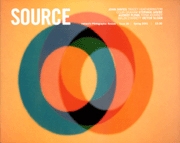Seeing Through the Comfort Blanket
'Face Value' by Phil Collins was at the Context Gallery, 5th - 27th January 2001
Review by Colin Darke
Issue 26 Spring 2001
View Contents ▸
Phil Collins' Face Value is made up of five parts - four series of photographs and a four-monitor video installation. Collins says that the theme running through the show is its critique of masculinity. This is true, but I feel it reaches beyond this to encompass a broader observation of human consciousness.
The video piece, The Marches 2000, sets the scene, revealing much about Collins' Concerns. Four monitors are placed on the floor and two large beanbags are provided for our comfort. The two central monitors show footage of last year's Orange marches at Drumcree and Belfast. The two outer ones, four flirtatious talking-head interviews which refer obliquely to the various forms of television communication, from the chat show, to vox-pop, to the news interview.
The piece exposes how the media reduces important issues to the level of entertainment and illustrates the two sides of alienated consciousness. The interviews show that for most of us it serves aS a comfort blanket that, in contrast to the nastiness on the other two screens, turns us into nice, uncomplicated people who put up with the shit.
There are two series of photographs which look at the US, one from within, one from without. The first, Better Society, consists of six from a number made last year in Los Angeles, documenting the lives of Santa Monica's homeless community, contrasting wealth and modernity with poverty and social exclusion. A car, placed against a backdrop of rows of palm trees, is crammed with waste paper and plastic bags. A man is seated on a crate, walking stick beside him, using a public telephone. A bottle in a brown paper bag leans against the pure white wall of the modernist building he faces. A grey-bearded man, sporting a dirty T- shirt, faces us, adjusting his sunglasses like the Arnie he could have been... or the cop. The first photograph in the series contains a number of policemen in riot gear, dominated by LAPD officer 16999, standing centre-stage, facing us in a laughably macho pose, clutching the all-important phallic truncheon. His face hidden in part behind his visor and reflecting shades, we can still make out the sneer, scary but absurd.
Also included are two images of his combatants, participating in last year's demonstration at the Democratic National Convention, protesting against the police brutality that 16999's pose signifies, along with America's legislation against gay people, trade unionists and immigrants. In the first, the demonstrator's eyes peer over his banner, behind him can be read the word 'pilgrim'. In a city street, gay activists raise their fists, faces masked with handkerchiefs. Both sides of the struggle are faceless and, as in Marches, we have portraits of alienation in conflict. on one side the state and on the other those in opposition to its oppression.
The US leaves its own shores to make its presence felt in the Belgrade 2000 works. Collins visited Belgrade last year and made video and still pieces. Here he shows six photographs which document America's cultural, as well as physical, imperialist presence.
The before and after is signified by an image of a postcard showing a castle in an idyllic landscape, now floating in a puddle of dirty grey water. Western influence is evident in the 'Club 54' nightclub, echoing Manhattan's own Studio 54 and in the hairdresser's window, which includes familiar pictures of exaggerated James Dean quiffs, strangely unBosnian.
Sandwiched between these two pieces of comic relief is a house which has been destroyed in a NATO strike, in which the occupants were killed. Collins uses the device of juxtaposing humour and horror to good effect here. We can view cultural imperialism with an ironic sideways glance, but when faced with the realities of war, they suddenly don't seem funny any more.
The final piece in the series can be read as a small act of anti-imperialist defiance. ln a close-up of an exterior wall, we see that someone has chalked the word 'Elvis'. A second person has added 'is dead'.
You're Not the Man You Never Were signifies a battle of another kind. Collins has twice suffered from testicular cancer and the four photographs in this series reflect on those experiences. The first refers metaphorically to the radium treatment that the artist has undergone. A gingerbread man lies flat, burning under the intense heat of a magnifying glass. Secondly, we have a portrait of the artist himself, seated before a window, administering his medication. He stares at us blankly, but with an air of defiance about him, disallowing any attempts at pathos. The third image is taken from the Belgrade series - an apartment block destroyed in a bomb attack. The façade of the house is decorated with square tiles, broken and falling and one section of the building has collapsed downwards - a cell structure invaded by Bosnia's own cancer. This is a mutual dialogue, where war acts as a metaphor for disease, and vice versa.
The foursome is completed by another self-portrait. Here, his torso alone is visible. He has lifted his jumper to show off his operation scar. His right arm crosses to hold his penis - flaccid, unlike our LAPD friend's magnificent display, hung on the same gallery wall. This an image of tenderness in the face of adversity.
The also-rans in the show are four photographs of the Belfast peaceline. The series is titled Pedestrian and frankly, compared to the rest of the show, it is. It completes, however, Phil Collins' analysis of human alienation that our social existence produces for us, and the ideological and physical conflict between working-class people that results from it.
Other articles by Colin Darke:
Other articles mentioning Phil Collins:






